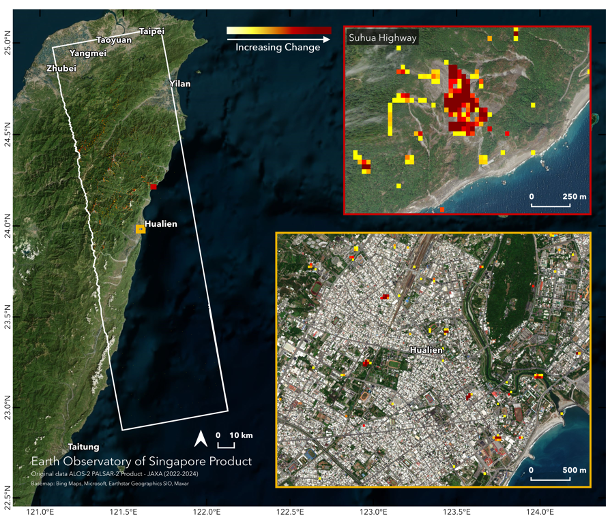The Mw7.4 earthquake that struck Taiwan on 3 April 2024 attracted much attention from around the world. The Earth Observatory of Singapore - Remote Sensing (EOS-RS) Lab produced a map showing some areas likely affected by the earthquake. Other EOS scientists addressed various media requests about the event, including its size and the triggered tsunami, the earthquake and tsunami hazard in Singapore, and what to do during an earthquake. Here are some of the comments and results they provided.
Which areas were likely affected by the earthquake?
EOS-RS used satellite data to generate a damage proxy map (DPM) for the region impacted by the earthquake. “The damage proxy map was produced after Sentinel Asia requested for support,” said Associate Professor Sang-Ho Yun, the Director of EOS-RS. Since 2017, EOS has been a member of Sentinel Asia, a voluntary initiative to share disaster information in near-real-time across the Asia-Pacific region.
To produce the map, EOS-RS used synthetic aperture radar images acquired before and after the event by a satellite operated by the Japan Aerospace Exploration Agency (JAXA). EOS-RS then disseminated the map through Sentinel Asia and on Twitter. “Sentinel Asia then shared the map with the Taiwan Space Agency,” said Assoc Prof Yun.

Damage proxy map produced by EOS-RS, which shows Earth surface changes between 17 Nov 2022/19 Oct 2023 and 4 Apr 2024 seen by the satellite, which are likely damaged areas. The colour variation from yellow to red indicates more surface change (Source: EOS-RS/EOS)
“The area of the map is the main city of Hualien, where it was reported that most people were affected by the earthquake. It also shows areas that were affected by landslides in mountainous regions,” said Mr Denny Chee, a student at the Asian School of the Environment (ASE) at Nanyang Technological University Singapore (NTU Singapore) who is part of the EOS-RS team.
The team often validates their results obtained from the satellite data with ground data that can be reports or photos of damaged building and infrastructure. This step gives confidence in the accuracy of the map. “I was able to find two particular buildings that are reported damaged in the news reports, and that correspond to two areas of surface change on the DPM. Videos shot by a news helicopter and by the public were helpful when they included landmarks such as coordinates, street names and building names,” said Mr Chee.
EOS-RS highlights that the map should be used as a guidance to identify damaged areas, and may be less reliable over vegetated areas. “We hope our maps can help with relief efforts,” said Assoc Prof Yun. “Our maps are often used for inspection priority: quickly identify areas to inspect that might have been affected by the earthquake.”
What caused the shaking, the tsunami and the landslides?
“Most of the island faces a significant level of seismic hazard as a result of active tectonic movements and faults,” said Assistant Professor Luca Dal Zilio, from NTU Singapore’s ASE and EOS, in an interview with The Straits Times.
The magnitude of an earthquake is only one factor affecting how strongly an earthquake is felt. “A hypothetical earthquake of a similar size in the uppermost 20 km of the crust would be expected to produce even stronger shaking than what was observed on April 3,” said Assistant Professor Aron Meltzner from NTU Singapore’s ASE and EOS, in the same article from The Straits Times. “In comparison with the 7.7-magnitude earthquake in Taiwan that struck in 1999, the April 3 one occurred in an area with lower population density and at a lower magnitude, which undoubtedly made a difference.”
The earthquake occurred offshore and displaced the seafloor, triggering tsunami warnings across multiple regions, including Taiwan, southern Japan, and the Philippines. “While there are no available records along the coasts of Taiwan, a tsunami wave height of 31 cm was measured at an island approximately 200 km offshore,” said Asst Prof Dal Zilio in The Straits Times article. “Thankfully, these warnings were eventually lifted without any major reported damage from the tsunamis,” he added in a separate note. “Although the tsunami did not flood inland, there are reports of strong currents and localised coastal flooding,” said Professor Adam Switzer from NTU Singapore’s ASE and EOS.
In addition to the tsunami, the earthquake also triggered several landslides – such tsunamis and landslides are called secondary hazards of the earthquake. “The earthquake occurred along some very steep mountain slopes and caused many rockslides and landslides in coastal north-eastern Taiwan,” said Dr Sharadha Sathiakumar, a Research Fellow at EOS “Landsides can cause extensive damage, and they can exacerbate the effects of the earthquake by severing access to areas impacted by the earthquake.”
What’s the seismic and tsunami hazard in Singapore?
“We are certainly not on a plate boundary, but there are faults that are mapped in Singapore like there are in many places in the world,” said Asst Prof Aron Meltzner, in an interview with CNA938. “One of the big questions is whether any of those faults are active.”
He added that “earthquakes do not know international borders”. For example, two earthquakes of magnitude over 5 occurred in 1922 in Johor which means that there are active faults in Johor, just across the border from Singapore. If people feel an earthquake in Singapore, Associate Professor Shengji Wei, from NTU Singapore’s ASE and EOS reminds in an interview with CNA938 to “drop, cover and hold.”
Regarding the potential for tsunamis to hit Singapore, Asst Prof Meltzner said that “the tsunami risk in Singapore is minimal”. If a tsunami was triggered from the Manila Trench off the coast of the Philippines, “the most we would expect is an amplitude of tens of centimetres, and we would have 10 to 12 hours of warning before the tsunami reaches us,” he added in his CNA938 interview.